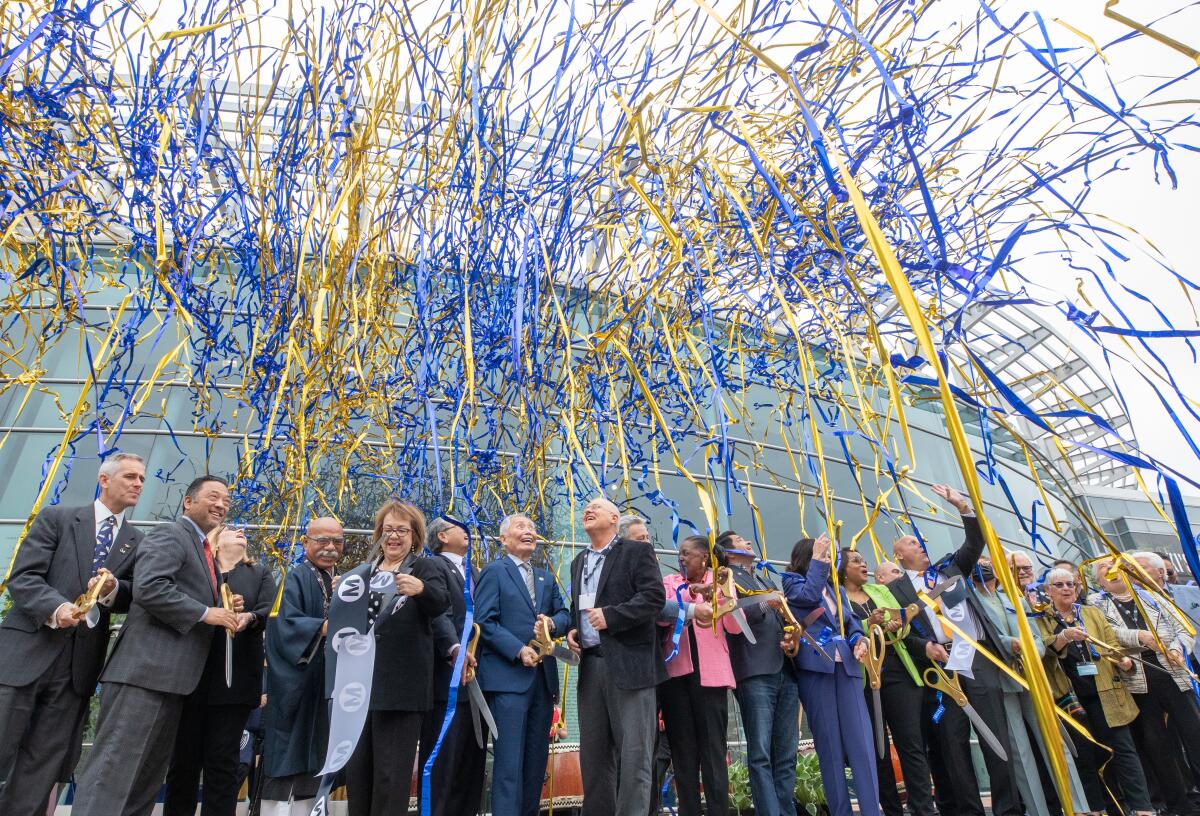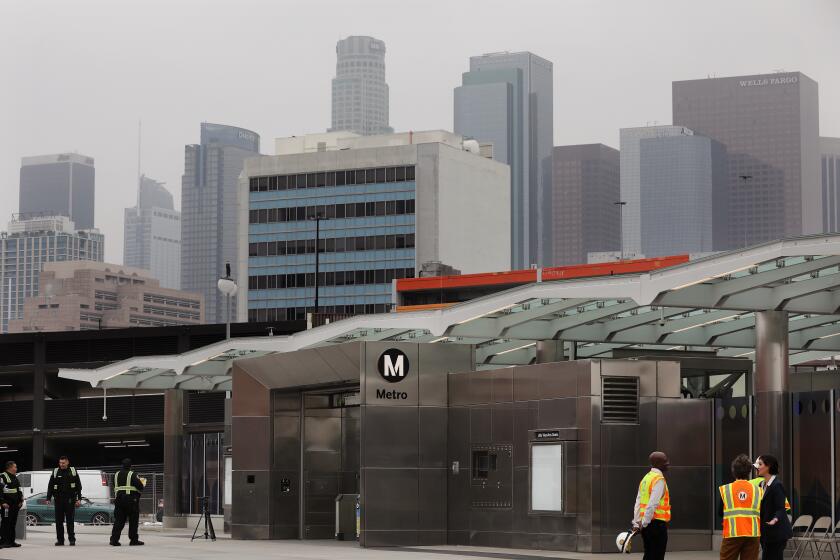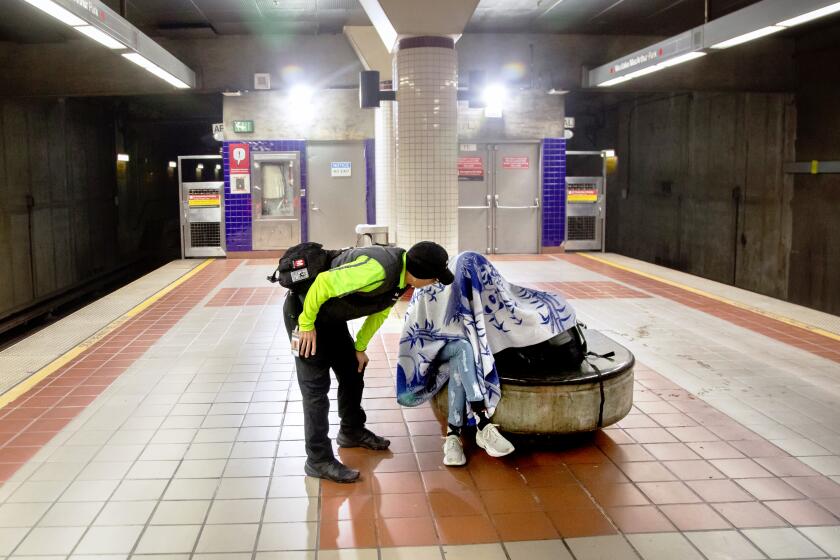Metro’s new rail connector opens in downtown L.A., linking three lines, reducing transfers

A 1.9-mile rail line with stops at some of downtown Los Angeles’ most iconic locations opened Friday to crowds hoping to take a spin on the new trains that transit officials say were the missing link in the system.
“It’s gonna be about half the time for me,” said Margarita Navarrete, a city clerk who commutes from East Los Angeles. Although she has a car, she normally takes a bus to avoid the cost of parking. The new rail line’s Historic Broadway Station will drop her across the street from her office.
The new Regional Connector ties together the L (Gold), A (Blue) and E (Expo) lines along one route underneath downtown Los Angeles, providing more direct access to the city’s center and in many cases eliminating the need to transfer. It enables riders to travel on one train nearly 50 miles from Azusa to Long Beach via the A line or East Los Angeles to Santa Monica via the E line.
The L line designation, formerly the Gold Line, retires with the opening of this track, although the E line adopts the gold color on Los Angeles County Metropolitan Transportation Authority signs. Rides will be free over Father’s Day weekend.
Hundreds of commuters, office workers and Metro employees gathered at the new Little Tokyo/Arts District station for the noon opening, snapping selfies and taking shots of the new station.
Regional Connector opens June 16 in downtown Los Angeles, eliminating transfers while linking Long Beach to Azusa, East L.A. to Santa Monica.
“I am hoping that this will connect the communities,” said Monica Vasquez, 32, who was among the first to ride the newly operating trains. “I have been waiting for a long time.”
It took nearly a decade to build the $1.8-billion rail route. The four-stop, subterranean light-rail line was three years behind schedule and $335 million over budget. Initial funding for the project came from the 2008 Measure R half-cent sales tax, but the bulk of the money came from nearly $1 billion in federal funding. State dollars helped close the gap.
“The Regional Connector is truly the missing link in Metro’s ever expanding rail system. And now that it’s completed, it will help catalyze ridership growth systemwide in the years ahead,” Ara Najarian, chair of the Metro board of directors, said during a jubilant opening ceremony hosted by George Takei of “Star Trek” fame.
Ridership plummeted after the pandemic, but it has been ticking upward. Planners hope the new connections will bolster commuter-usage. It’s expected that 90,000 riders will take the regional connector daily by 2035.
On Friday, workers were still putting up signs that said, “No Loitering.” Metro has stationed ambassadors, security, outreach workers and law enforcement at the new line as part of a public safety campaign amid a wave of violent incidents.
There are emergency safety boxes to call inside the station, although there was no cell service in large swaths of the underground Historic Broadway Station and the Grand Ave Art/Bunker Hill Station. Metro said it is working to ensure there is a cell signal at the subterranean stations in the coming months.
Trains run every 10 minutes during rush hour, 12 minutes during middays and weekends, and 20 minutes at night.
On the light-rail platform, office workers and transit fans had their cellphones pointed at the track as the trains approached.
Zoyla Pinacho, 35, recorded her 2- and 4-year-old children as they ran along the mezzanine of the Grand Ave Arts/Bunker Hill Station, where a 61-foot mural towers alongside a bank of elevators.
Metro workers watch and wait as drug overdoses unfold -- or go rogue to save lives. One has revived 21 riders.
She pointed to her children.
“They are obsessed with trains,” she said as they nudged her toward a map of the system.
Los Angeles, better known for its car culture, has been in the midst of an ambitious public transit build out. Over the past year, Metro opened the K Line, not far from Pinacho’s house. The rail line runs connects to the E (Expo) line, running along Crenshaw Boulevard and eventually linking to a people mover to the Los Angeles International Airport. Subway construction is also underway to Westwood. And more plans are under way for the San Fernando Valley and the Sepulveda Pass.
“It’s nice to see the development,” she said.
Inside the E line train to Little Tokyo, Art Gardner of Mar Vista sat listening to a podcast. He said the new connector will save him money on Uber fares and his overall commute time.
“I’m looking forward to this, “ he said.
Gardner grew up in Southern California learning that cars were freedom. But after giving up his car for public transit some years back, he realized what a toll the traffic was taking on his peace of mind. He doesn’t mind the longer commute time on the train.
“It takes longer, but when I get to where I am going, I don’t want to kill anyone,” he said jokingly. “It keeps me sane.”
More to Read
Sign up for Essential California
The most important California stories and recommendations in your inbox every morning.
You may occasionally receive promotional content from the Los Angeles Times.












